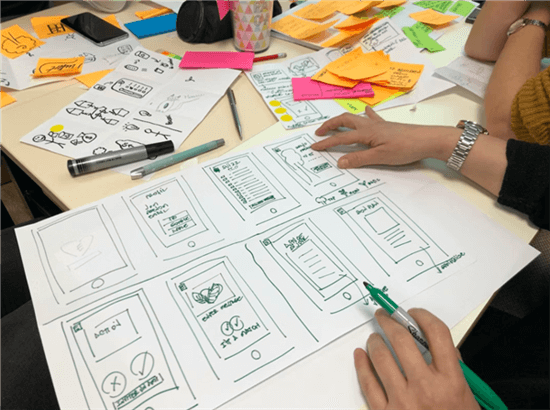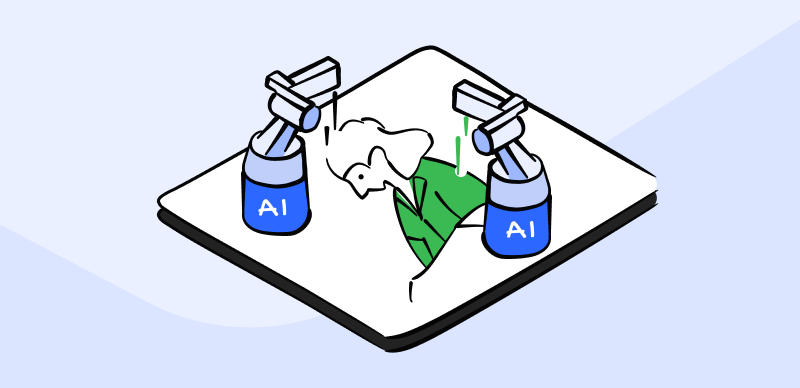In the recent age of change and the online world, conventional ways of strategizing a business are long gone. People and businesses are finding ways and learning new methods to keep up with innovation and technology. When you hear the term innovation, the concept of design thinking must fill your mind with curiosity as it did ours. Design thinking has been credited for bringing large-scale innovation in problem-solving tactics. Keep scrolling to learn more about what is design thinking and why is it important, and equip yourself with the required knowledge.

Overview of Design Thinking
What is Design Thinking?
Design thinking is an innovative approach to identifying problems and creating solutions. This approach literally hijacks the user’s mental model and uses it for its own good- in a healthy way. It focuses on the issues and pain points of the users and proceeds in a user-centric manner to address them. It has its unique process, with each stage carrying its value.
It is a constructive and dynamic iterative design process, and experimentation, testing, and feedback constitute its core. Each factor is considered behind design thinking, and users are involved in each step, which is why it is also considered under the User-Centered Design process. Walk with us to know about what is design thinking and why is it important in today’s age of business and industries.

What is a Design Thinking
Why is Design Thinking Important?
Design thinking is the concept that has revolutionized the way of problem-solving methods. It figures out the problem, empathizes with the users, comes up with ideas to address, and follows up with feedback to resolve it. Following are five reasons which state the significance of design thinking and how it works to bring your business back to life.
Solves Problems with Innovation
Design thinking helps tackle problems that are not properly defined, are vague, or haven’t yet appeared. Because you look at your design from a user’s perspective, you put your needs in the backseat and design in a way that aids the users of the product/ service. It helps you approach problems creatively and adds creativity and fun.
Makes Users Feel Acknowledged
Design thinking revolves around gathering user feedback and testing, which involves users’ opinions throughout the designs. The final product eventually has a good outcome in terms of user experience. This approach successfully meets the customers’ needs and makes them feel valued.
Encourages Growth of A Business
Design thinking ensures fruitful growth and success of a business. Since the products are designed in a user-centered approach, the sales reach the target revenue and sometimes even more. It pushes a business to do better and fulfill the user’s requirements with new products. It enables a business to stay ahead of the curve and flourish.
Ensures A Simple and Seamless User Experience
Design thinking emphasizes building businesses with simplicity and puts the user at ease. While accessing online sites and other modern technology, a user sometimes faces strong sensory overload. Integrating design thinking simplifies everything 10x, and users can perform their goals comfortably and with decreased difficulty.
The Principles of Design Thinking
Design thinking follows a standard principle method for every product/ service. In this way, it builds and works around solving and eradicating problems in an efficient and organized manner. In this paragraph, we will shed light on how design works and improves business at a micro level. Please keep reading to know more about its basic principles and their importance in design thinking.
An Empathetic Approach Toward the User’s Pain Points
The first principle which carries the most significance is empathy. By empathy, we don’t just mean understanding the problems a user faces regarding a product/ service. Empathy with your user falls under this, but it means finding solutions and methods to ease those difficulties. You must put yourself in your user’s shoes and think from their point of view. To navigate and learn about their needs, habits, and requirements for a product/ service. It requires extra work, but it is worth it. The target audience is the main character of your business, so special attention must be paid to eradicate their pain points. You can leverage personas and user journeys to gather information about the user.
Collaboration Between Teams
After discovering the problems a user faces regarding any product/ service, the next vital principle follows, which is communication and collaboration between teams. Multidisciplinary teams work on one thing, and design thinking must bring them together. Evaluation of the issues a user faces is discussed, and steps should be taken to ensure resolving them.
Simplicity
Simplicity always comes first for a catchy user experience. Wondering why? Because it displays designs that are straightforward and to the point. Products that are created with an element of simplicity attract users more. So, it is imperative to keep this mindset while doing design thinking. It hones the ability of a product to do better and reach its target revenue.
Ideate
After discovering the user’s pain points and issues, we move towards finding ideas that will lead us to solutions. Design thinking must comprise ideas quantitatively. Design thinking must ensure that the ideas generated resolve a certain problem and overcome any upcoming challenges a user might face. This principle is the backbone of design thinking and adds reliability and stability to a business.

How to Find Ideas of Design Thinking
Be mindful Of Setbacks
Design thinking must encourage the team to make room for shortcomings and setbacks. Not every day. We do things right in the first go. Huge companies have had their share of lackings. So it must give the designers and businesses the margin of error and constructive improvement.
Experimental Outlook
Prototyping falls under the area of design thinking. After collecting ideas and thoughts for a problem, design thinking should encourage you to develop prototypes, wireframing, and other forms of expression. It is an iterative process, and user feedback and opinions should be considered throughout the journey. This feedback system helps designers improvise and cater to the user’s needs. Usability testing is one of the most recognized ways of attaining users’ true feedback regarding a particular product.
Room For Change
Design thinking pushes the system to be flexible. Flexibility ensures room for change and improvement. For instance, you design a product that does not do well in the market, so you design another one in replacement. Design thinking encourages this mindset and saves efforts, time, and resources.
Frequently Asked Questions
1. Why is testing important in the process of design thinking?
Testing is crucial in the process of design thinking because it helps in the assessment and evaluation of the design. It helps look at products from a user’s perspective by encouraging feedback via usability testing. Testing also makes users feel considered and important in the process because their opinions are valued.
2. What are a few design thinking tools that ease the design thinking process?
Many online tools can assist you in all the stages of design thinking. The names of the most well-performing ones include Stormboard, Miro, Microsoft Visio, Mind Genius, Proto.io, Excel, and Xplenty.
The tools mentioned above are required for different purposes in design thinking. These tools will aid you in crafting better designs.
3. What kind of skill is design thinking?
Design thinking is originally a soft skill that combines Emotional Intelligence and problem-solving abilities.
Final Words
Unlike conventional problem-solving methods, there are ways to alleviate issues and problems before they overcome a business and put them in a dark place. One of the well-recognized ones is design thinking. This article addresses the importance and principles of design thinking to equip you with the information you need. Always remember the more you keep up with innovation methods, the more you improve your business. If you have any unsolved queries about what is design thinking and why is it important, comment below, and we will get back to you in no time.


